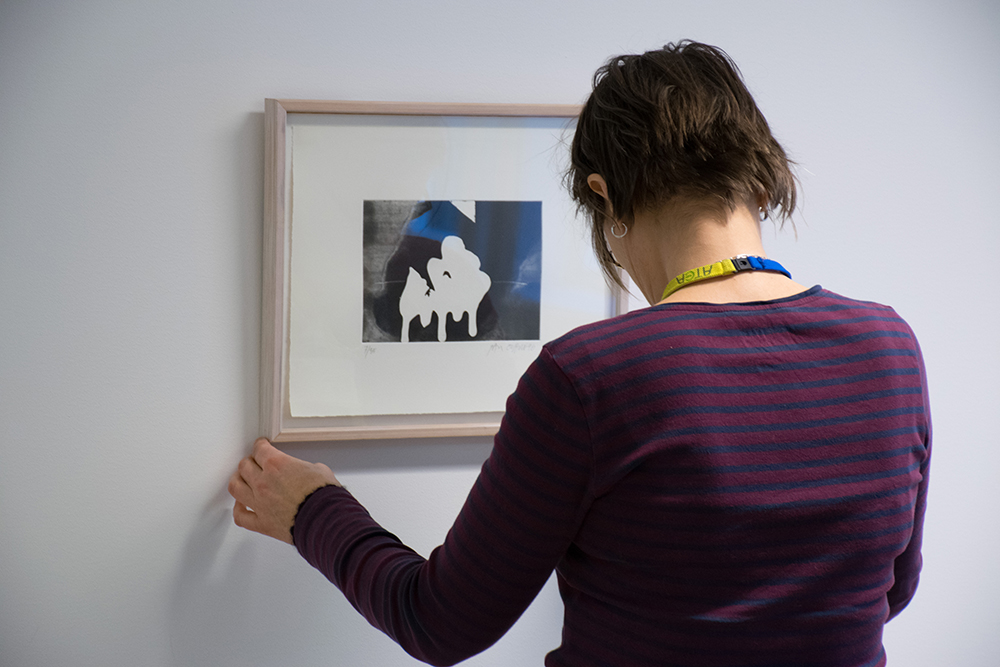Hanna Stahle has created an art collection for the Swedish Agency for Economic and Regional Growth’s Stockholm office. Comprising some 40 works, the collection spans everything from sculpture to embroidery. Stahle has adapted the collection to the newly renovated premises in order to identify works that will harmonise with the environment, which, in itself, has a striking identity designed by an interior architect.

Hanna explains her collection:
“My initial idea was to go all-in and create a graphically powerful collection with a preponderance of black-and-white and greyscale, highly suited to the newly renovated, light and elegant premises. Most artworks come into their own in a pared-back environment and for some works it is an absolute requirement. I am happy to have been able to place some really nice works here, which will definitely receive the attention they deserve.”
The offices of the Swedish Agency for Economic and Regional Growth are distributed over three floors and designed as open workplaces. The ground floor is to a large extent occupied by the reception area and a number of conference rooms. The two upper floors contain individual workplaces, lounge-type sofa environments and more traditional office landscapes. The interior design is characterised by a multitude of colours and types of furniture, possibly with the intention of creating variation and playfulness with the aim of fostering a creative environment. The design has presented both a challenge and has been an asset; meeting and conference rooms are often natural places for hanging art but in this case the walls were covered by photo wallpaper. Hanna was thus forced to explore other locations for placing the artworks, which has created a creative and dynamic hanging.
“The works placed on the premises communicate with one another as well as with the environment and rooms in which they have been installed.”
The building is elongated with two long, parallel corridors on each floor. On one side of the corridors, smaller conference rooms and secluded workplaces are screened off by glass walls, while the other side, facing the interior of the building, is mainly composed of walls with niches. Several of these niches, which face the smaller conference rooms, have been used by Hanna for installing art, as the works placed here are visible both for people passing through the corridors and for those working in the rooms behind the glass walls.
The works communicate with one another as well as with the environment and the rooms in which they have been placed. In the reception area on the entrance floor, an intricate ceramic sculpture by Karin Jaxelius including a growing structure interacts with Catrin Andersson’s two works whose charcoal lines also extend in an organic manner across the paper, while the blueish wall colour is picked up by the glaze of the ceramic sculpture, the tone of which shifts from grey to white and includes light blue elements.
While placing the works, Hanna has worked with both a contrast effect and hangings that blend in with the interior architecture. The rose tone of Lars-Olov Wiberg’s work creates a contrasting point in the green corridor and captures the viewer’s gaze while Laris Strunke’s light pastel colour painting is accentuated by the darker, grey wall on which it hangs, without, however, provoking an extreme contrast. On the middle of the three floors, Anton Alvarez’s The Thread-Wrapping Machine: High Side Table has been installed in a niche facing an open meeting area in between the parallel corridors. From a distance, the graphic patterns created by the black-and-white thread are clearly visible, and close up, one also sees the actual wooden structure, composed of round bars and wooden pieces that are held together by the spun thread.
Hanna was also commissioned to integrate and rehang a number of existing artworks in her collection, including two felt works that belong to the National Swedish Handicraft Council (Nämnden för hemslöjdsfrågor), who share the premises with the Swedish Agency for Economic and Regional Growth. One of these works was placed in conjunction with a sculpture by Björn Therkelsson in a niche where they interact with their tones of dark grey. The surface of Therkelsson’s bronze sculpture is reminiscent of a knitted sock and the wall decoration’s short stumps of felt create a pattern with textile and sewing connotations, albeit with irregular stitches and ladders.
Common to all three floors is Mikael Lundberg’s Entropy Series 17, which recur in unexpected places. As indicated by the title, the work comprises 17 parts. Before the building was renovated, the 17 components were hung together and have now, in collaboration with the artists, been relocated and hung separately, creating a common thread through the building. Certain parts are somewhat secluded and perhaps not immediately visible upon entering the building but appear if one takes a detour through a different corridor from one’s normal route. Placing works in this way creates a tension; there are new things to discover by looking in an unexpected place.